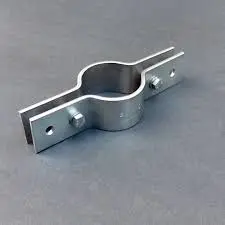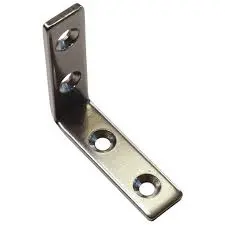What are mounting metal brackets used for?
2025-03-18 16:02:49
Mounting metal brackets are essential hardware components used in various construction, installation, and DIY projects. These versatile pieces of hardware serve as crucial connectors and supports in both residential and commercial applications. From supporting shelves and cabinets to securing structural elements, mounting metal brackets play a vital role in ensuring stability and safety across multiple industries and applications.

How do you choose the right mounting metal brackets for your project?
Understanding Load Capacity Requirements
The selection of appropriate mounting metal brackets begins with a thorough assessment of load-bearing requirements. When choosing mounting metal brackets, it's crucial to consider the total weight they will need to support, including both static and dynamic loads. Professional contractors typically recommend selecting brackets rated for at least 1.5 times the intended load to ensure a safety margin. The load capacity of mounting metal brackets varies significantly based on their design, material composition, and thickness. For instance, heavy-duty steel brackets might support several hundred pounds, while lighter aluminum brackets are better suited for decorative applications or minimal loads. Engineers and architects often specify particular mounting metal brackets based on detailed structural calculations and building codes.
Material and Finish Considerations
The material selection for mounting metal brackets significantly impacts their durability and performance in different environments. Stainless steel mounting metal brackets offer superior corrosion resistance and are ideal for outdoor installations or humid environments like bathrooms and kitchens. Galvanized steel brackets provide excellent strength and moderate corrosion resistance at a lower cost point. Aluminum mounting metal brackets, while lighter in weight, offer natural corrosion resistance and are perfect for applications where weight is a concern. The finish of mounting metal brackets also plays a crucial role in both aesthetics and longevity, with options ranging from powder-coated surfaces for enhanced durability to brushed finishes for a modern appearance.
Installation Requirements and Compatibility
The installation process and compatibility factors are critical when selecting mounting metal brackets. Different mounting surfaces require specific bracket designs and installation methods. For instance, mounting metal brackets intended for concrete walls need different anchoring systems compared to those designed for drywall or wooden studs. The spacing and number of mounting points, the type of screws or bolts required, and the overall bracket geometry must all align with the installation requirements. Professional installers emphasize the importance of choosing mounting metal brackets that come with clear installation instructions and are compatible with standard fastening systems available in the market.
What are the most common applications for mounting metal brackets?
Residential Construction Applications
In residential construction, mounting metal brackets serve numerous essential functions. They are frequently employed in kitchen installations, where heavy-duty mounting metal brackets support upper cabinets, floating shelves, and countertop overhangs. Bathroom fixtures such as vanities and storage cabinets rely on properly installed mounting metal brackets for secure attachment to walls. In living spaces, these brackets facilitate the installation of entertainment centers, bookcases, and decorative shelving. The versatility of mounting metal brackets extends to exterior applications, where they support awnings, light fixtures, and outdoor storage solutions. Contractors often specify commercial-grade mounting metal brackets for these applications to ensure long-term stability and safety.
Commercial and Industrial Uses
The commercial and industrial sectors utilize mounting metal brackets in more demanding applications. In warehouses, heavy-duty mounting metal brackets support extensive shelving systems, conveyor belts, and mechanical equipment. Office buildings employ these brackets for mounting HVAC ductwork, electrical conduit systems, and network cable trays. Industrial facilities rely on specialized mounting metal brackets for securing machinery, pipes, and safety equipment to walls and floors. These applications often require custom-designed mounting metal brackets that meet specific load requirements and safety standards while complying with industrial building codes and regulations.
DIY and Home Improvement Projects
The DIY market has embraced mounting metal brackets for various home improvement projects. Homeowners frequently use these brackets to create custom storage solutions, garage organization systems, and workshop installations. Mounting metal brackets enable the construction of workbenches, tool storage walls, and garden equipment organizers. The availability of decorative mounting metal brackets has also led to their use in creative projects such as floating desks, wall-mounted plant displays, and custom furniture pieces. DIY enthusiasts appreciate the flexibility and strength that mounting metal brackets provide, allowing them to complete professional-looking installations without specialized construction knowledge.

What factors affect the durability of mounting metal brackets?
Environmental Impact and Protection
Environmental conditions significantly influence the longevity of mounting metal brackets. Exposure to moisture, humidity, and temperature fluctuations can accelerate corrosion and deterioration if proper protective measures aren't taken. High-quality mounting metal brackets often incorporate protective coatings or are manufactured from corrosion-resistant materials to combat these environmental challenges. In coastal areas, where salt air poses additional corrosion risks, specialized marine-grade mounting metal brackets are recommended. Indoor applications also require consideration of environmental factors, such as exposure to cleaning chemicals or temperature variations, which can affect the performance of mounting metal brackets over time.
Installation Quality and Maintenance
The proper installation and ongoing maintenance of mounting metal brackets directly impact their durability. Professional installers emphasize the importance of following manufacturer specifications for mounting procedures, including proper anchor selection and torque requirements. Regular inspection of mounting metal brackets helps identify potential issues before they become serious problems. Maintenance practices such as cleaning, checking for loose fasteners, and addressing any signs of corrosion can significantly extend the service life of mounting metal brackets. Professional maintenance programs often include scheduled inspections and preventive measures to ensure the continued reliability of critical bracket installations.
Load Distribution and Stress Factors
The way loads are distributed across mounting metal brackets affects their long-term performance. Proper spacing and alignment of brackets ensure even load distribution and prevent localized stress points that could lead to failure. Engineers design mounting metal brackets with specific load patterns in mind, incorporating features such as gussets and reinforcement ribs to handle anticipated stresses. Understanding and respecting the load limits of mounting metal brackets is crucial for maintaining their structural integrity over time. Professional installations often include additional brackets or support structures for applications where loads approach the maximum rated capacity of individual mounting metal brackets.
Conclusion
Mounting metal brackets are indispensable components in construction and installation projects, offering versatile solutions for supporting various loads and structures. Their applications span residential, commercial, and industrial settings, with specific considerations for selection, installation, and maintenance ensuring optimal performance. Understanding these factors is crucial for successful implementation and long-term durability. If you want to get more information about this product, you can contact us at info@qdkshd.com.
References
1. Smith, J.R. (2023). "Modern Construction Hardware: A Comprehensive Guide to Mounting Solutions." Building Technology Press.
2. Anderson, M.K. & Thompson, R.D. (2023). "Industrial Applications of Metal Brackets and Supports." Journal of Construction Engineering, 45(2), 78-92.
3. Wilson, P.A. (2022). "Residential Construction Methods: Hardware Selection and Installation." Professional Builder's Guide Series.
4. Brown, S.L. & Davis, C.M. (2024). "Metal Bracket Design and Load Analysis." Structural Engineering Quarterly, 18(4), 156-170.
5. Roberts, H.T. (2023). "Commercial Construction Hardware: Selection and Specification Guide." Construction Industry Publications.
6. Zhang, L. & Johnson, K.R. (2023). "Durability Analysis of Construction Hardware in Various Environments." Materials Performance Journal, 12(3), 45-58.
Send Inquiry
You may like
